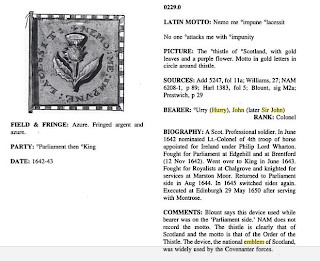Sir John Hurry (or Urry) was born in Monymusk, Aberdeenshire, and gained his military experience, like most Scot's, fighting in the Thirty Years Wars. In 1639 he returned to Scotland, to serve the Covenant in the Bishops Wars. In 1641, he was approached by royalist conspirators in a plot against the Earls of Lanark, Argyll and the Marquis of Hamilton. However, he revealed the details of the plot (known as "the Incident") to Leslie.
When the war broke out in England he initially joined the Parliamentary side where he fought at the siege of Portsmouth and battles of Edgehill and Brentford under Essex. Promotion followed but not of a rank which Hurry felt sufficient, so he promptly deserted to the Royalist cause in Oxford. With the information he brought on Parliaments dispositions, Rupert acted at once, leading a raid which resulted in the Royalist victory at Chalgrove Field and the death of John Hampden. As a reward, the king knighted Hurry and gave him an independent cavalry command. Thereafter, he led these troops behind Essex's army into Buckinghamshire, causing widespread panic as far afield as London.
As Rupert moved north, he accompanied the army to Marston Moor. Here he fought alongside Sir Charles Lucas on the victorious Royalist left wing, but with little avail to the overall result. Again, Hurry defected and although initially the Committees of both Kingdoms ordered his arrest, he was again allowed to join the Parliamentary forces in October 1644.
In early January, 1645, Hurry was appointed Major General and Colonel of Dragoons with the Army of the Solemn League and Covenant. Here he was appointed second in command to Lieutenant General William Baillie, and sent north to deal with Montrose. Unfortunately, Baillie had little like for Hurry, remembering they had faced each other at Marston Moor, which ultimately reflected in some of the poor coordination between the two in the coming campaign.
Initially Hurry captured Aberdeen, only to march away the next day. Furthermore his pursuit (or lack of) after the sack of Dundee brought little but disdain from Baillie. However, it was Baillie who divided his forces resulting in Hurry fighting alone at Auldearn. Here, he fought well and although defeated was one of the last to leave the field (albeit on a swift horse). He resigned his commission, perhaps through pressure from the Committee or Ballie, under the time honored guise of ill-health.
His recovery was quick, and he fought on the side of the king (and covenant) during the 2nd and 3rd Civil Wars. However, by siding with the Engagers and the Duke of Hamilton, his card was marked by the Covenanter Committee of Estates. Although captured at Preston in 1648, he escaped to the continent where he found favor with the royal court in exile.
He was appointed Major General to Montrose for the ill-fated Carbisdale campaign, where he was wounded and captured. This time he was unable to escape his fate and the long list of his erstwhile enemies/allies lined up to see him beheaded in Edinburgh on the 29th of May 1650.
Hurry was "a soldier of fortune of great bravery, experience and skill, his frequent changes of front were due rather to laxity of political principles than to any calculated idea of treason". In effect he changed his colors one two many times, pissing off everyone he knew, driven only by blind ambition and greed..
The figures are again Eureka Miniatures. Hurry is the Lord Gordon figure but whose to say he doesn't look like the man (maybe his flowing locks are a bit to flamboyant for a protestant). The standard bearers grey turned out really nice to paint but the detail was crisp and sharp on all the miniatures. The actual guidion is Hurrys, described below.










